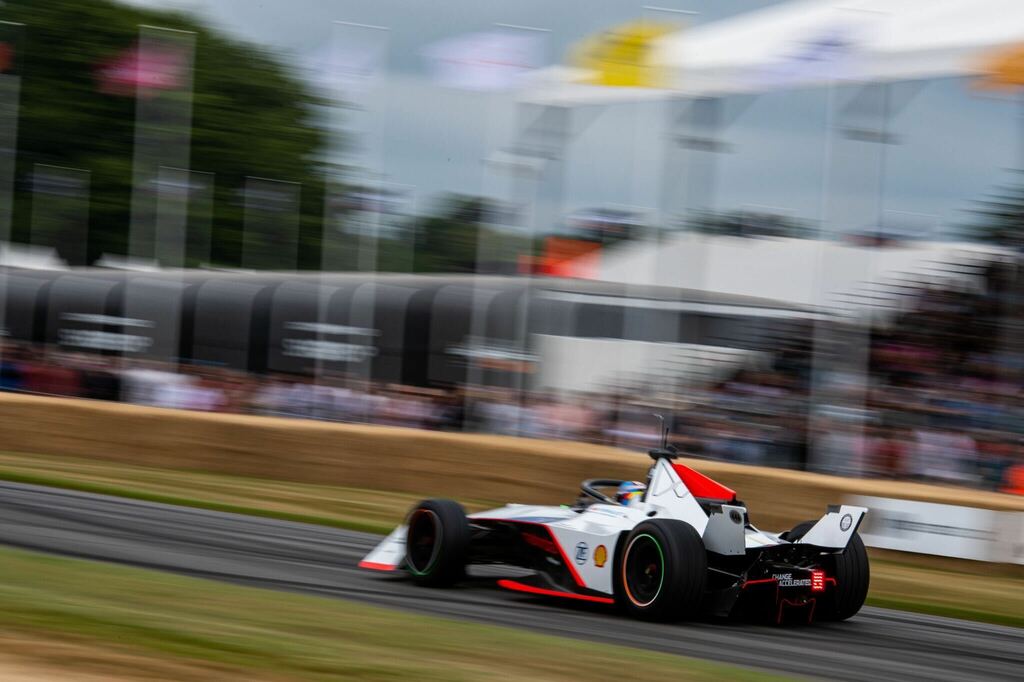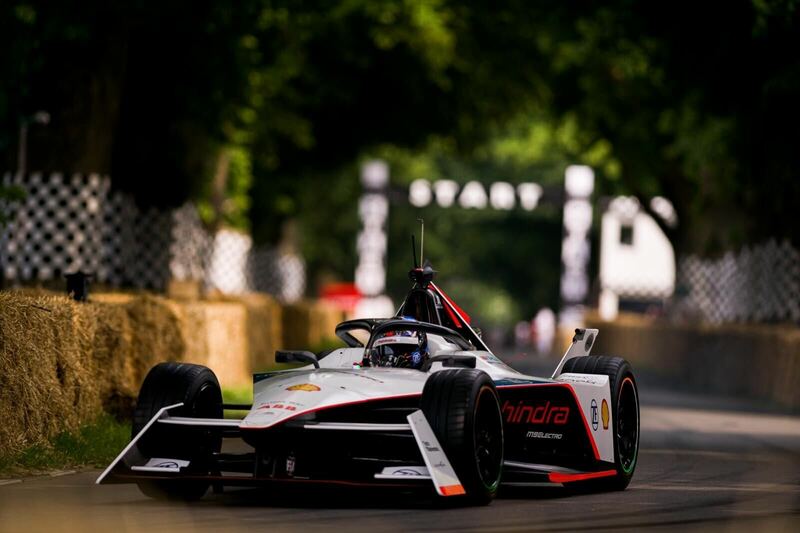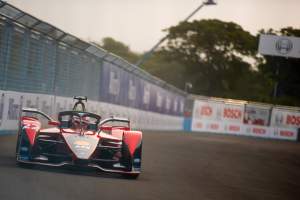All of the registered manufacturers have now completed at least a day of testing their divisive Gen3 test cars, and while there have been varying amounts of mileage collated, the consensus that a hugely concertinaed time frame for completing preparations remains.
As reported by The Race earlier this month the British-based manufacturers – Jaguar, Mahindra and NIO 333 tested at RAF Abingdon in Oxfordshire, UK, while last week Nissan, Porsche and DS undertook two days of running at the Calafat circuit near Tarragona in Spain.
Manufacturers have several key deadlines to hit in the coming months as their new cars are homologated in early October for two seasons until the end of 2024.
One of those manufacturers, Mahindra, has given The Race some insight into the demands of the new car after it ran its development car for four days at the Goodwood Festival of Speed last week.
Nick Heidfeld drove the car, which was assembled 10 days before and completed a shakedown at Abingdon with Oliver Rowland at the wheel the previous week.
The German saw his 23-year-old hillclimb record – which he set in a McLaren MP4/13 – broken yesterday by Max Chilton in McMurtry Automotive Speirling’s fan car.
Mahindra had special authorization to use full power at Goodwood even though its running came under the limited filming day stipulations. Usually, filming days are limited to 110kW of power.
One of the engineering leaders of the Gen3 project, which is set to be called the Mahindra M9Electro, is technical director Lewis Butler. He outlined one of the early key goals of the Gen3 car, which will see a power hike from 250kW to 350kW in qualifying trim.

“The peak power cap isn’t quite enough to reach the peak loads in the braking (yet),” said Butler.
“That’s one of the key things to try and get on top of early in our programme, and also to ensure we understand what we need for the tyre balance in racing and also qualifying spec.”
“At the minute it’s only allowing us to do regen but the power cap for that is not enough to allow us to completely replace the front brakes at high speed.
“So, in basic terms, there is just more complexity at a system’s level on this car. There’s a lot to do in the few months that we’ve got.”
Butler also highlighted a previously unknown fact about the new Williams Advanced Engineering pouch-celled battery unit which will provide the usable energy for Gen3 racing.
Rumours had circulated that the new component runs hotter than the old Gen2 battery meaning that specific conditioning will come into play.
“We actually condition it to be warmer rather than cooler to run it properly at the right power levels,” said Butler. “So, there’s basically a lot to learn in terms of this from the very start, as well as the primary challenges of the new tyres and the powertrain kit.”
All of the manufacturers have started the testing by carrying out work on mapping their hardware and in particular the unique braking set-ups of the Gen3 car.

This will see no rear hydraulic brakes on the car because a front powertrain (MGU) will have sufficient regenerative capability.
The Race understands that several manufacturers have already hit issues related to the brakes, but these are believed not to be of great worry or significance at this early stage of testing.
“In terms of the challenges between knowing about the friction brakes on both cars, it’s quite similar,” said Butler.
“There’s only one axle on this car and in some ways that makes it easier as the rear is now entirely brake free. There’s obviously more reliance on the powertrain from ZF which is really good from our side.
“There’s more standard parts at the back of the car than there used to be too.”
The standardised dampers will be supplied by Sachs, a company owned by Mahindra’s major technical partner, the ZF Group.
It is also known that the FIA has carried through its plans to have bespoke torque sensors on the driveshafts of the Gen3 cars. This is to try and keep in check any ersatz traction control systems which are known to have been rife in the championship throughout the Gen2 period. Traction control is outlawed in the world championship.
The jury is still out on new Hankook tyres as the teams gather further data on the Korean company’s first foray into all-weather competition rubber for a single-seater championship.
Butler reckons that differently constructed sidewalls will be one of the key features for teams to get competitive advantages for 2023.
“This is a bespoke developed product, whereas I think the Michelin tyre initially anyway, wasn’t really, it was more of a road hybrid design in some respects.
“The way the Hankook sidewalls are constructed is quite different on this tyre and the way it runs in terms of pressure characterisation too. That will be interesting to see how everyone works with those new challenges.”
Nick Heidfeld confessed to The Race that his runs at Goodwood were more about showcasing the new car rather than continuing his reputation as a Goodwood hillclimb specialist.
Here’s the first glimpse of the @FIAFormulaE Gen 3 car. The @MahindraRacing Gen 3 car has @NickHeidfeld at the wheel and he’s not holding back. What do you think of the new design?#M9Electro #Gen3 #FOS #FormulaE pic.twitter.com/DsFLMxrGg7
— Goodwood FOS (@fosgoodwood) June 23, 2022
The former Mahindra race driver, who hung up his competitive helmet in Formula E four years ago said that the braking of the Gen3 car was one of the areas where drivers will again be able to “make the difference” in Gen3 Formula E racing.
“For me also, especially having the possibility now to play with the front (powertrain), the brakes and also to regenerate the power there, I think this is something completely new for most of us in the motorsport world,” said Heidfeld.
“Ok, probably in rallying there was, not regeneration, but the possibility to play with the front axle, so for me this is something new exciting and something where probably one can make a difference.”
“It felt good, the controllability feels good, there is enough retardation available. Obviously, it’s new, not having any hydraulic brake system on the rear.
“It looks a bit strange if you’re used to cars and race cars not to see brake discs on the rear. But this is just technology evolving and I think in the near future, we will be used to them.”
Gooood morning from Goodwood!
Wake yourself up with the first ever ride on-board of our M9Electro driven here by @fosgoodwood hero @NickHeidfeld… pic.twitter.com/5VIjUclSOP
— Mahindra Racing (@MahindraRacing) June 25, 2022
Heidfeld also gave insight into the cockpit view of the Gen3 car which from the outside looks a lot different to the Gen2 in that it appears cleaner and easier to judge the front of the car with its more classic open-wheeled design.
“I find that an interesting question because it seems quite a lot of people think it’s going to be much different or not sufficient. But from the first moment I got in the car, I didn’t even think about it,” said the ex-Sauber, BMW and Jordan F1 driver.
“For me, at least here without racing against other cars, it’s not an issue at all and don’t I don’t assume it will be an issue.”
Gen3 images courtesy of Mahindra/Lou Johnson






